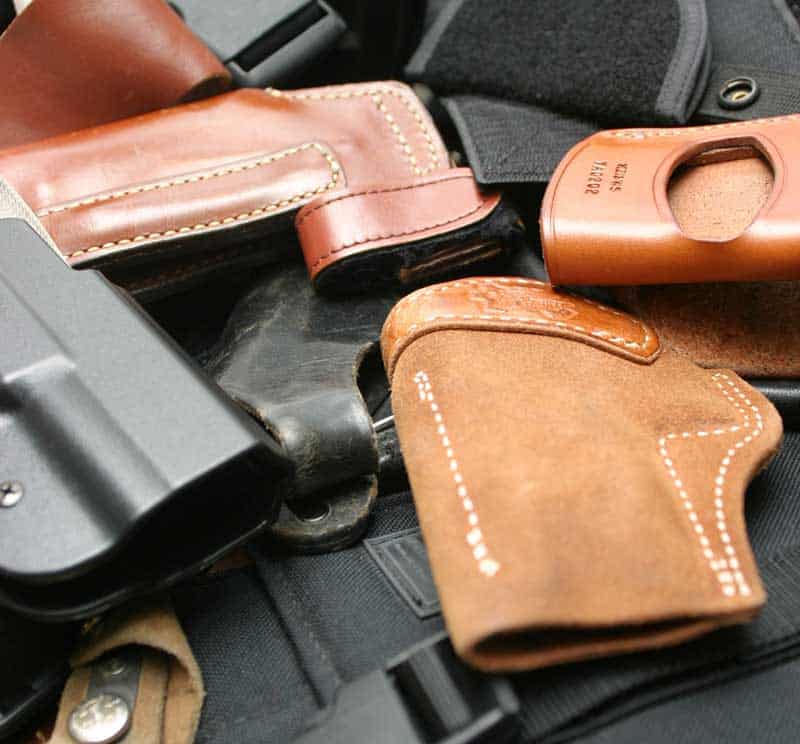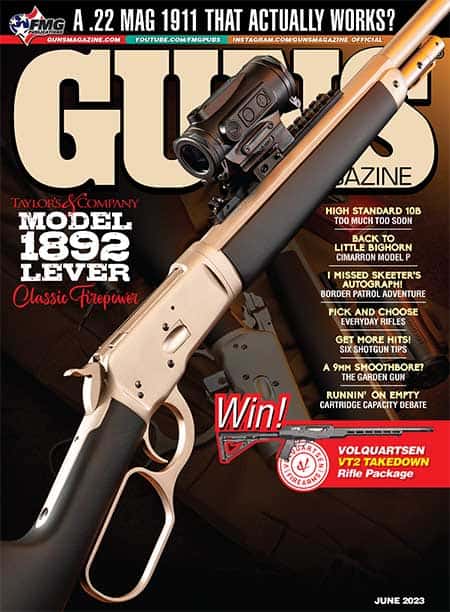Don’t lose it!
“Holster retention” isn’t just for cops
Recently, during one of our Gun Cranks video episodes, American Handgunner editor Tom McHale made a remark that lodged squarely in my brain. In fact, it caused a mild cogitation and ultimately evolved into an acute case of pondering.
We were chatting about holsters when Tom mentioned “handgun retention” and how important it is for your pistol-carrying-device to retain its payload, even during vigorous physical activity or direct assault by an assailant.
Protecting and keeping your firearm against all aggressors foreign and domestic is second nature to an old cop but I had never heard it discussed in terms of non-law enforcement, “normal earth people” who carry guns for self-defense. However, I realized though the threat scenarios are different, the principles of gun retention aren’t just for the boys and girls in blue, brown, green, tan or whatever.
THE RULE
If you’re following Rule #1 of gunfighting — Always Carry A Gun — there is no worse feeling in the world than reaching for said firearm in the heat of battle and having your hand close around nothing but thin air. I’ve been in this exact situation and it is, as they say, “sub-optimal.”
In my case, it took six weeks for various sphincters to finally unclench.
Though not often discussed in the CCW world, having your handgun unintentionally leave the holster is, at minimum, a major embarrassment and at far-worse end of the spectrum, a potentially lethal event for someone. Consequently, let’s talk about keeping your gun where it normally belongs.
The Benchmarks
The companies who manufacture holsters used for the cop duty gear have come up with a 1-through-5 rating system for retention. Level 1 is basically something used to hold a firearm, while level 5 generally requires a coded secret password, approval from several federal government officials in triplicate and a 17-step procedure to get the gun out of the “leather.” Think “2-man Nuclear Missile Launch sequence” but more drawn-out. Everything else falls in between but since it’s a voluntary (i.e., marketing) system, there is no real standard here.
Fortunately for our purposes, “Level 1” is fine because most of us are wearing concealment garments. In our daily experience, the holster basically just has to fit the gun and protect it against loss. However, all holsters are not created equal.
An adequate holster should meet several criteria — it should hold the gun in place against the force of gravity, protect the trigger guard to prevent negligent discharges, keep the firearm always secure in the same place on your person and remain open enough to facilitate re-holstering in the event things suddenly become a non-shooting situation. For the aesthetic crowd, it would also be nice if it looked nice.
Using this basic scorecard, you can see how some popular holsters don’t meet the requirements, while other designs such as the Yaqui slide work just fine even though it mostly resembles a leather G-string.
Now let’s take the deeper dive and see what these standards actually mean.
Criteria
First, a good holster will retain the gun against the force of gravity, meaning the firearm stays in place even if you fall, slip, hang from your toes or otherwise end up in some non-standard non-vertical position. If you’ve ever seen a person stumble and cause their gun to suddenly go frisking across the terrazzo like a crackhead Easter Bunny, you understand why this is important. It’s also fairly easy to grasp the complications arising if your gun suddenly appears on the ground next to your opponent during non-lethal grappling or fisticuffs.
Secondly, a properly functioning gun won’t go bang unless you pull the trigger so any device used to carry a firearm on your person should protect the trigger and trigger guard. If you are going to ignore everything else said here, please don’t overlook this one simple design factor — the bullet you prevent from accidentally firing might have your name on it!
In regards to a certain formerly popular holster, which uses a trigger-finger-activated release, what can I say except “Don’t”? Yes, the design is fast and intuitive, but the documented results have shown some people play a little too fast and get hot lead in the leg or foot for their trouble. It has happened too many times to count, which is why many training centers and ranges have banned these holsters.
A holster should also keep the gun in one place until you move it. If you must obtain your pistol in an emergency, having it drifting randomly around your waistline isn’t exactly the best approach to a smooth and fast draw stroke.
This is where the notorious belt clip holster often fails. My current everyday carry rig does utilize a belt clip but it is so well-built, robust and aggressive, I frequently require a team of professional riggers to take off my slacks. Most cheap rigs aren’t this strong and somewhere in my home is a box of discarded holsters with belt clips bent and splayed due to various mishaps.
In one case, a clip barely caught on a door frame after my shirt rode up, then over-extended briefly, recoiled backwards then slapped my back fat so hard I thought I’d been shot through the love handles. As it were, the holster was ruined and I had a weird bruise to explain to my wife. Fortunately, I didn’t lose my gun, but the lesson is simple — don’t buy cheap belt-clip holsters.
Probably the most-overlooked or ignored requirement for a CCW holster is the ability to stay open after the gun has been withdrawn. In nearly every circumstance where a pistol is presented, you’ll eventually need to return the gun to its garage. Whether the threat has downgraded, you need two hands to fight or escape, or you need to perform first aid, being able to easily stow your gun can be a critical issue.
After all, even if the threat abated for the moment, it doesn’t mean you won’t need your gun a second time. If it has already started to slide down your pants after being stuffed into your waistband or it’s lying on a dumpster just across the alley, you’ve voluntarily disarmed yourself.
As a side note, don’t take this as an endorsement of “speed holstering,” a technique that is apparently now a thing on the internet. If you required a gun in your hand, there really isn’t a legitimate necessity to shift into reverse and put it to bed as fast as possible. I predict this latest online tactical fad will quickly disappear once a few more people have butt-shot themselves.
Um, no.
Speaking of stuffing guns in your waistband, do as I say and not as a do! As a young cop, I went through a phase where such “South of the Border” off-duty carry was common — at least until the day the slide stop caught in my underwear band and I almost had to audition for the Vienna Boys Choir after trying to extract my firearm. Of course, there were innumerable other times my gun inexorably started sinking into my drawers like a leaky submarine. Very uncool.
Probably the biggest and most common mistake regarding holsters is spending too little in purchasing one. I’ve seen countless times where someone dropped many hundreds or even thousands of dollars on a handgun, then proudly carried it around in a $15 nylon pouch secured with a flimsy strap. You know the kind — they come in plastic clamshells at big-box stores. It’s unfortunate such holsters don’t also come with a complimentary T-shirt with the words “Gun Rube” or “Raging Newbie” on the front so we’d know who to avoid on the range.
Just go ahead and spend a little more to get a quality holster of the brand and type you desire so long as it meets this basic criterion we’ve discussed.
Therefore, now fully learnt after today’s discussion, if your new GonzoBlaster 500XL accidentally drops out of your holster and falls down the storm drain grate, don’t blame me. Such things never happen to professional, experienced pistoleros such as Your Humble Correspondent.
A second time.

Get More Carry Options content!
Sign up for the newsletter here:




